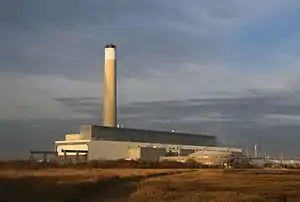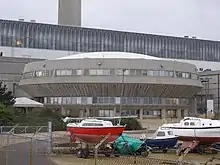Fawley Power Station
Fawley Power Station was an oil-fired power station located on the western side of Southampton Water, between the villages of Fawley and Calshot in Hampshire, England. Its 198-metre (650 ft) chimney is a prominent (and navigationally useful) landmark, but it is not, as is sometimes claimed, the highest point in Hampshire (which is Pilot Hill).
| Fawley Power Station | |
|---|---|
 Fawley Power Station | |

| |
| Country | England |
| Location | Hampshire, South East England |
| Coordinates | 50.816696°N 1.328881°W |
| Construction began | 1965 |
| Commission date | 1971 |
| Decommission date | 2013 (Demolished in 2019) |
| Owner(s) | Central Electricity Generating Board (1971–1990) RWE npower (1990–2013) |
| Operator(s) | Central Electricity Generating Board (1971–1990) RWE npower (1990–2013) |
| Thermal power station | |
| Primary fuel | Oil-fired |
| Secondary fuel | Fuel oil for auxiliary gas turbines |
| Chimneys | 1 (198 m) |
| Cooling towers | None |
| Cooling source | Sea water |
| Power generation | |
| Units operational | 4 × 500 MW |
| Annual net output | 5271.594 GWh (Year 1980/81) |
grid reference SU473021 | |
Overview
The station, which in its final years was owned and operated by Npower, was oil-fired, powered by heavy fuel oil. A pipeline connected the station to the nearby Fawley oil refinery. Because oil is more expensive than other fuels such as coal and natural gas, Fawley did not operate continuously, but came on line at times of high demand.
It was also connected to the National Grid with circuits going to Nursling and a tunnel under Southampton Water to Chilling then to Lovedean with a local substation at Botley Wood.
A dock was included in the construction, to allow for the delivery of oil by sea; however, after one ship delivery (essentially a trial) this facility remained disused.
History
Fawley was built by Mitchell Construction Architect Colin Morse RIBA[1] for the CEGB between 1965[2] and 1969.[3] It was commissioned in 1971 as a 2,000-megawatt (MW) power station, with four 500 MW generating units, each consisting of a boiler supplying steam to a turbine that powers an associated generator. The boilers were capable of delivering 1788.0 kg/s of steam at 158.6 bar and 538°C.[4] The cooling pumps were Britain's largest with a flow of 210,000 GPM. One was driven by an experimental super-conducting electric motor.
The operating data for the main plant is shown in the table:[5]
| Year | Net capability, MW | Electricity supplied, GWh | Load as percent of capability, % | Thermal efficiency, % |
|---|---|---|---|---|
| 1972 | 2,000 | 7,059.640 | 48.5 | 34.38 |
| 1979 | 1,932 | 10,047.995 | 59.4 | 35.53 |
| 1981 | 1,932 | 5,271.594 | 31.1 | 34.24 |
| 1982 | 1,932 | 4,723.965 | 27.9 | 36.87 |
| 1984 | 1,932 | 2,007.425 | 11.8 | 34.27 |
| 1985 | 1,932 | 12,980.721 | 76.7 | 37.87 |
| 1986 | 1,932 | 2,110.406 | 12.5 | 35.18 |
| 1987 | 1,932 | 4,234.020 | 25.0 | 36.223 |
The electricity output, in GWh, is shown graphically:
The high output in 1984/5 as associated with the 1984/5 Miners' Strike, and the shortage of coal for coal-fired power stations. There were also 4 × 17.5 MW auxiliary gas turbine generators on the Fawley site giving a total output of 70 MW, these machines had been commissioned in September 1969.[4][6]
Two units were mothballed in 1995,[7] leaving the station with a capacity of only 1,000 MW.
On 18 September 2012, RWE npower announced they would be shutting down Fawley power station by the end of March 2013, due to the EU Large Combustion Plant Directive.[8] The power station was duly shut on 31 March 2013. The decommissioning and demolition of the plant is expected to take several years, and the future of the site remains undecided.[9]
Proposed Fawley B station
CEGB plans for a coal-fired Fawley B station were not pursued following privatisation of the industry in the late 1980s.
Impact on wildlife
When the plant was operating the screens on the plants cooling water lines were found to kill as many as 50,000 fish a week.[10] By the 80s intermittent plant operation meant that the annual kill total was around 200,000.[10] While this may have resulted in reduced numbers of some species such as bass others like sand smelt seemed unaffected.[10]
Media

The unique round structure housing the control room for the station was used to represent the "World Control Center" building depicted in the 1975 movie Rollerball.[11]
Some scenes for the 2015 movie Mission: Impossible – Rogue Nation were filmed on location at Fawley power station.[12]
The second series of British medical comedy Green Wing featured a scene that was shot in the control room.
In the Red Dwarf (series XI) the episode "Give and Take" had a scene that was filmed inside the control room.
The 2017 Channel 4 programme Spies filmed at the station and inside the control room.
The final episode Harvest of series 4 of Endeavour used the power station and control room.
The exterior of the power station was used as a filming location for the Star Wars film Solo: A Star Wars Story.[13]
The location was used as the extraction point for the 2018 series of Celebrity Hunted. The successful fugitives escaped by speedboat, exiting into Southampton Water.
Regeneration
In 2017 it was announced that the power station site would be turned into over 1,500 homes. The project went on display to the public on 27 September 2017.[14]
See also
References
- Indictment: Power & Politics in the Construction Industry, David Morrell, Faber & Faber, 1987, ISBN 978-0-571-14985-8
- "Building of the month March 2015 - Fawley Power Station". Retrieved 2 October 2020.
- "Fawley Power Station chimney". skyscraperpage.com. Retrieved 25 May 2020.
- CEGB Statistical Yearbook, 1980-81, CEGB, London
- CEGB Statistical Yearbooks 1971-1987, CEGB, London.
- The Electricity Council (1990). Handbook of Electricity Supply Statistics. London: The Electricity Council. p. 8. ISBN 085188122X.
- "Generation disconnections since 1991". nationalgrid.com. 2003. Archived from the original on 5 December 2012. Retrieved 5 October 2008.
- "Power Stations To Be Closed Down By Npower". Archived from the original on 21 September 2012. Retrieved 18 September 2012.
- "Fawley power station closes after 41 years". BBC News. 2 April 2013. Retrieved 24 September 2013.
- Tubbs, Colin (1999). The Ecology, Conservation and History of the Solent. Packard Publishing. p. 40. ISBN 1853411167.
- "Film Buffs may notice that the round control room was the World Control Centre in 1975 film Rollerball". Sam Farr/The Bath Chronicle.
- "Scenes for Tom Cruise's Mission Impossible 5 will be filmed at Fawley Power Station in Hampshire". Southern Daily Echo. 7 November 2014.
- "PHOTOS: Behind the scenes shots as Star Wars films at Fawley Power Station". Daily Echo.
- Yandell, Chris (27 September 2017). "Exhibition showcases plan to replace Fawley Power Station with 1,500 homes and luxury marina". Daily Echo.
| Wikimedia Commons has media related to Fawley Power Station. |
